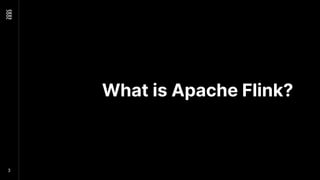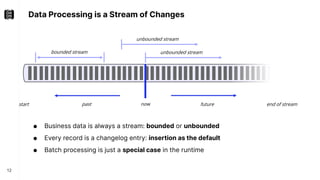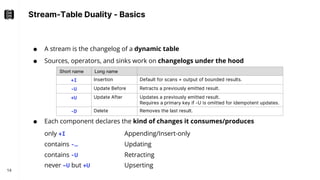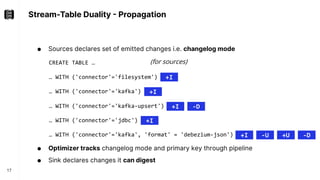Changelog Stream Processing with Apache Flink
- 1. Changelog Stream Processing with Apache Flink Timo Walther @twalthr – Flink Forward 2022 2022-08-03
- 2. About me Open source ● Long-term committer since 2014 (before ASF) ● Member of the project management committee (PMC) ● Top 5 contributor (commits), top 1 contributor (additions) ● Among core architects of Flink SQL Career ● Early software engineer @ DataArtisans ● SDK team @ DataArtisans/Ververica (acquisition by Alibaba) ● SQL team lead @ Ververica ● Co-founder @ Immerok 2
- 3. What is Apache Flink? 3
- 4. Building Blocks for Stream Processing 4 Time ● Synchronize ● Progress ● Wait ● Timeout ● Fast-forward ● Replay State ● Store ● Buffer ● Cache ● Model ● Grow ● Expire Streams ● Pipeline ● Distribute ● Join ● Enrich ● Control ● Replay Snapshots ● Backup ● Version ● Fork ● A/B test ● Time-travel ● Restore
- 5. What is Apache Flink used for? 5 Transactions Logs IoT Interactions Events … Analytics Event-driven Applications Data Integration ETL Messaging Systems Files Databases Key/Value Stores Applications Messaging Systems Files Databases Key/Value Stores
- 7. API Stack 7 Dataflow Runtime Low-Level Stream Operator API Optimizer / Planner Table / SQL API DataStream API Stateful Functions
- 8. DataStream API 8 StreamExecutionEnvironment env = StreamExecutionEnvironment.getExecutionEnvironment(); env.setRuntimeMode(STREAMING); DataStream<Integer> stream = env.fromElements(1, 2, 3); stream.executeAndCollect().forEachRemaining(System.out::println); Properties ● Exposes the building blocks for stream processing ● Arbitrary operator topologies using map(), process(), connect(), ... ● Business logic is written in user-defined functions ● Arbitrary user-defined record types flow in-between ● Conceptually always an append-only / insert-only log! 1 2 3 Output
- 9. Table / SQL API 9 TableEnvironment env = TableEnvironment.create(EnvironmentSettings.inStreamingMode()); // Programmatic Table table = env.fromValues(row(1), row(2), row(3)); // SQL Table table = env.sqlQuery("SELECT * FROM (VALUES (1), (2), (3))"); table.execute().print(); Properties ● Abstracts the building blocks for stream processing ● Operator topology is determined by planner ● Business logic is declared in SQL and/or Table API ● Internal record types flow, Flink’s Row type is exposed in Table API ● Conceptually a table, but a changelog under the hood! +----+-------------+ | op | f0 | +----+-------------+ | +I | 1 | | +I | 2 | | +I | 3 | Output
- 10. DataStream API ↔Table / SQL API 10 StreamExecutionEnvironment env = StreamExecutionEnvironment.getExecutionEnvironment(); StreamTableEnvironment tableEnv = StreamTableEnvironment.create(env); // Stream -> Table DataStream<?> inStream1 = ... Table appendOnlyTable = tableEnv.fromDataStream(inStream1) DataStream<Row> inStream2 = ... Table anyTable = tableEnv.fromChangelogStream(inStream2) // Table -> Stream DataStream<T> appendOnlyStream = tableEnv.toDataStream(insertOnlyTable, T.class) DataStream<Row> changelogStream = tableEnv.toChangelogStream(anyTable) Mix and match APIs!
- 11. Changelog Stream Processing 11 Change is the law of life and those who look only to the past or present are certain to miss the future. John F. Kennedy
- 12. Data Processing is a Stream of Changes 12 ● Business data is always a stream: bounded or unbounded ● Every record is a changelog entry: insertion as the default ● Batch processing is just a special case in the runtime now past future start end of stream bounded stream unbounded stream unbounded stream
- 13. How do I Work with Streams in Flink SQL? 13 ● You don’t. You work with dynamic tables! ● A concept similar to materialized views CREATE TABLE Revenue (name STRING, total INT) WITH (…) INSERT INTO Revenue SELECT name, SUM(amount) FROM Transactions GROUP BY name CREATE TABLE Transactions (name STRING, amount INT) WITH (…) name amount Alice 56 Bob 10 Alice 89 name total Alice 145 Bob 10 So, is Flink SQL a database? No, bring your own data and systems!
- 14. Stream-Table Duality - Basics 14 ● A stream is the changelog of a dynamic table ● Sources, operators, and sinks work on changelogs under the hood ● Each component declares the kind of changes it consumes/produces only +I Appending/Insert-only contains -… Updating contains -U Retracting never –U but +U Upserting Short name Long name +I Insertion Default for scans + output of bounded results. -U Update Before Retracts a previously emitted result. +U Update After Updates a previously emitted result. Requires a primary key if -U is omitted for idempotent updates. -D Delete Removes the last result.
- 15. Stream-Table Duality - Example 15 An applied changelog becomes a real (materialized) table. name amount Alice 56 Bob 10 Alice 89 name total Alice 56 Bob 10 changelog +I[Alice, 89] +I[Bob, 10] +I[Alice, 56] +U[Alice, 145] -U[Alice, 56] +I[Bob, 10] +I[Alice, 56] 145 materialization CREATE TABLE Revenue (name STRING, total INT) WITH (…) INSERT INTO Revenue SELECT name, SUM(amount) FROM Transactions GROUP BY name CREATE TABLE Transactions (name STRING, amount INT) WITH (…)
- 16. Stream-Table Duality - Example 16 An applied changelog becomes a real (materialized) table. name amount Alice 56 Bob 10 Alice 89 name total Alice 56 Bob 10 +I[Alice, 89] +I[Bob, 10] +I[Alice, 56] +U[Alice, 145] -U[Alice, 56] +I[Bob, 10] +I[Alice, 56] 145 materialization CREATE TABLE Revenue (PRIMARY KEY(name) …) WITH (…) INSERT INTO Revenue SELECT name, SUM(amount) FROM Transactions GROUP BY name CREATE TABLE Transactions (name STRING, amount INT) WITH (…) Save ~50% of traffic if downstream system supports upserting!
- 17. Stream-Table Duality - Propagation 17 ● Sources declares set of emitted changes i.e. changelog mode ● Optimizer tracks changelog mode and primary key through pipeline ● Sink declares changes it can digest CREATE TABLE … … WITH ('connector'='filesystem') … WITH ('connector'='kafka') … WITH ('connector'='kafka-upsert') … WITH ('connector'='jdbc') … WITH ('connector'='kafka', 'format' = 'debezium-json') +I +I +I -D +I -U +U -D +I (for sources)
- 18. Retract vs. Upsert 18 Retract ● No primary key requirements ● Works for almost every external system ● Supports duplicate rows ● In distributed system often unavoidable à most flexible changelog mode à default mode Upsert ● Traffic + computation optimization ● In-place updates (idempotency) SELECT c, COUNT(*) FROM ( SELECT COUNT(*) AS c FROM T GROUP BY user ) GROUP BY c Count 1 Subtask 1 Count 2 Subtask 1 Subtask 2 +U[1] +U[2] +I[…] 1=>1 2=>1 Subtask 2 +I[…]
- 19. Changelog Insights – Append-only 19 CREATE TABLE Transaction (tid BIGINT, amount INT); CREATE TABLE Payment (tid BIGINT, method STRING); CREATE TABLE Result (tid BIGINT, …); // accepts all changes INSERT INTO Result SELECT * FROM Transactions T JOIN Payments P ON T.tid = P.tid; Sink(table=[Result], changelogMode=[NONE]) +- Join(leftInputSpec=[NoUniqueKey], rightInputSpec=[NoUniqueKey], changelogMode=[I]) :- Exchange(changelogMode=[I]) : +- TableSourceScan(table=[[Transaction]], changelogMode=[I]) +- Exchange(changelogMode=[I]) +- TableSourceScan(table=[[Payment]], changelogMode=[I])
- 20. Changelog Insights – Updating 20 CREATE TABLE Transaction (tid BIGINT, amount INT); CREATE TABLE Payment (tid BIGINT, method STRING); CREATE TABLE Result (tid BIGINT, …); INSERT INTO Result SELECT * FROM Transactions T LEFT JOIN Payments P ON T.tid = P.tid; Sink(table=[Result], changelogMode=[NONE]) +- Join(leftInputSpec=[NoUniqueKey], rightInputSpec=[NoUniqueKey], changelogMode=[I,UB,UA,D]) :- Exchange(changelogMode=[I]) : +- TableSourceScan(table=[[Transaction]], changelogMode=[I]) +- Exchange(changelogMode=[I]) +- TableSourceScan(table=[[Payment]], changelogMode=[I])
- 21. Changelog Insights – Updating with PK 21 CREATE TABLE Transaction (tid BIGINT, amount INT); CREATE TABLE Payment (tid BIGINT, method STRING); CREATE TABLE Result (tid BIGINT, …, PRIMARY KEY(tid) NOT ENFORCED); INSERT INTO Result SELECT * FROM Transactions T LEFT JOIN Payments P ON T.tid = P.tid; Sink(table=[Result], changelogMode=[NONE], upsertMaterialize=[true]) +- Join(leftInputSpec=[NoUniqueKey], rightInputSpec=[NoUniqueKey], changelogMode=[I,UB,UA,D]) :- Exchange(changelogMode=[I]) : +- TableSourceScan(table=[[Transaction]], changelogMode=[I]) +- Exchange(changelogMode=[I]) +- TableSourceScan(table=[[Payment]], changelogMode=[I])
- 22. Changelog Insights – Updating with PK 22 CREATE TABLE Transaction (tid BIGINT, …, PRIMARY KEY(tid) NOT ENFORCED); CREATE TABLE Payment (tid BIGINT, …, PRIMARY KEY(tid) NOT ENFORCED); CREATE TABLE Result (tid BIGINT, …, PRIMARY KEY(tid) NOT ENFORCED); INSERT INTO Result SELECT * FROM Transactions T LEFT JOIN Payments P ON T.tid = P.tid; Sink(table=[Result], changelogMode=[NONE]) +- Join(leftInputSpec=[UniqueKey], rightInputSpec=[UniqueKey], changelogMode=[I,UA,D]) :- Exchange(changelogMode=[I]) : +- TableSourceScan(table=[[Transaction]], changelogMode=[I]) +- Exchange(changelogMode=[I]) +- TableSourceScan(table=[[Payment]], changelogMode=[I])
- 23. Mode Transitions 23 Append-only Retracting Updating through operation if operator/sink requires it ChangelogNormalize if sink requires it UpsertMaterialize
- 24. Mode Transitions – Characteristics 24 Append-only ● Event-time column backed by watermarks ● Highly state efficient due to notion of completeness ● Usually no event-time column ● State usage needs to be kept in mind ● Pure materialized view maintenance Retracting Updating aka "TABLE" aka "STREAM" aka ?
- 25. Demo 29
- 26. Summary TLDR ● Flink's SQL engine is a powerful changelog processor ● Flexible tool for integrating systems with different semantics There is more… ● CDC connector ecosystem à 2.6k Github stars https://flink-packages.org/packages/cdc-connectors ● Table Store unified storage engine for dynamic tables à native changelog support à deep integration into Flink SQL "like a DB" https://flink.apache.org/news/2022/05/11/release-table-store-0.1.0.html 30















![Stream-Table Duality - Example
15
An applied changelog becomes a real (materialized) table.
name amount
Alice 56
Bob 10
Alice 89
name total
Alice 56
Bob 10
changelog
+I[Alice, 89] +I[Bob, 10] +I[Alice, 56] +U[Alice, 145] -U[Alice, 56] +I[Bob, 10] +I[Alice, 56]
145
materialization
CREATE TABLE Revenue
(name STRING, total INT)
WITH (…)
INSERT INTO Revenue
SELECT name, SUM(amount)
FROM Transactions
GROUP BY name
CREATE TABLE Transactions
(name STRING, amount INT)
WITH (…)](https://image.slidesharecdn.com/215pmchangelogprocessingwithapacheflink-220809110543-62c3f603/85/Changelog-Stream-Processing-with-Apache-Flink-15-320.jpg)
![Stream-Table Duality - Example
16
An applied changelog becomes a real (materialized) table.
name amount
Alice 56
Bob 10
Alice 89
name total
Alice 56
Bob 10
+I[Alice, 89] +I[Bob, 10] +I[Alice, 56] +U[Alice, 145] -U[Alice, 56] +I[Bob, 10] +I[Alice, 56]
145
materialization
CREATE TABLE Revenue
(PRIMARY KEY(name) …)
WITH (…)
INSERT INTO Revenue
SELECT name, SUM(amount)
FROM Transactions
GROUP BY name
CREATE TABLE Transactions
(name STRING, amount INT)
WITH (…)
Save ~50% of traffic if downstream system supports upserting!](https://image.slidesharecdn.com/215pmchangelogprocessingwithapacheflink-220809110543-62c3f603/85/Changelog-Stream-Processing-with-Apache-Flink-16-320.jpg)

![Retract vs. Upsert
18
Retract
● No primary key requirements
● Works for almost every external system
● Supports duplicate rows
● In distributed system often unavoidable
à most flexible changelog mode
à default mode
Upsert
● Traffic + computation optimization
● In-place updates (idempotency)
SELECT c, COUNT(*) FROM (
SELECT COUNT(*) AS c
FROM T
GROUP BY user
)
GROUP BY c
Count 1
Subtask 1
Count 2
Subtask 1
Subtask 2
+U[1]
+U[2]
+I[…]
1=>1
2=>1
Subtask 2
+I[…]](https://image.slidesharecdn.com/215pmchangelogprocessingwithapacheflink-220809110543-62c3f603/85/Changelog-Stream-Processing-with-Apache-Flink-18-320.jpg)
![Changelog Insights – Append-only
19
CREATE TABLE Transaction (tid BIGINT, amount INT);
CREATE TABLE Payment (tid BIGINT, method STRING);
CREATE TABLE Result (tid BIGINT, …); // accepts all changes
INSERT INTO Result SELECT * FROM Transactions T JOIN Payments P ON T.tid = P.tid;
Sink(table=[Result], changelogMode=[NONE])
+- Join(leftInputSpec=[NoUniqueKey], rightInputSpec=[NoUniqueKey], changelogMode=[I])
:- Exchange(changelogMode=[I])
: +- TableSourceScan(table=[[Transaction]], changelogMode=[I])
+- Exchange(changelogMode=[I])
+- TableSourceScan(table=[[Payment]], changelogMode=[I])](https://image.slidesharecdn.com/215pmchangelogprocessingwithapacheflink-220809110543-62c3f603/85/Changelog-Stream-Processing-with-Apache-Flink-19-320.jpg)
![Changelog Insights – Updating
20
CREATE TABLE Transaction (tid BIGINT, amount INT);
CREATE TABLE Payment (tid BIGINT, method STRING);
CREATE TABLE Result (tid BIGINT, …);
INSERT INTO Result SELECT * FROM Transactions T LEFT JOIN Payments P ON T.tid = P.tid;
Sink(table=[Result], changelogMode=[NONE])
+- Join(leftInputSpec=[NoUniqueKey], rightInputSpec=[NoUniqueKey], changelogMode=[I,UB,UA,D])
:- Exchange(changelogMode=[I])
: +- TableSourceScan(table=[[Transaction]], changelogMode=[I])
+- Exchange(changelogMode=[I])
+- TableSourceScan(table=[[Payment]], changelogMode=[I])](https://image.slidesharecdn.com/215pmchangelogprocessingwithapacheflink-220809110543-62c3f603/85/Changelog-Stream-Processing-with-Apache-Flink-20-320.jpg)
![Changelog Insights – Updating with PK
21
CREATE TABLE Transaction (tid BIGINT, amount INT);
CREATE TABLE Payment (tid BIGINT, method STRING);
CREATE TABLE Result (tid BIGINT, …, PRIMARY KEY(tid) NOT ENFORCED);
INSERT INTO Result SELECT * FROM Transactions T LEFT JOIN Payments P ON T.tid = P.tid;
Sink(table=[Result], changelogMode=[NONE], upsertMaterialize=[true])
+- Join(leftInputSpec=[NoUniqueKey], rightInputSpec=[NoUniqueKey], changelogMode=[I,UB,UA,D])
:- Exchange(changelogMode=[I])
: +- TableSourceScan(table=[[Transaction]], changelogMode=[I])
+- Exchange(changelogMode=[I])
+- TableSourceScan(table=[[Payment]], changelogMode=[I])](https://image.slidesharecdn.com/215pmchangelogprocessingwithapacheflink-220809110543-62c3f603/85/Changelog-Stream-Processing-with-Apache-Flink-21-320.jpg)
![Changelog Insights – Updating with PK
22
CREATE TABLE Transaction (tid BIGINT, …, PRIMARY KEY(tid) NOT ENFORCED);
CREATE TABLE Payment (tid BIGINT, …, PRIMARY KEY(tid) NOT ENFORCED);
CREATE TABLE Result (tid BIGINT, …, PRIMARY KEY(tid) NOT ENFORCED);
INSERT INTO Result SELECT * FROM Transactions T LEFT JOIN Payments P ON T.tid = P.tid;
Sink(table=[Result], changelogMode=[NONE])
+- Join(leftInputSpec=[UniqueKey], rightInputSpec=[UniqueKey], changelogMode=[I,UA,D])
:- Exchange(changelogMode=[I])
: +- TableSourceScan(table=[[Transaction]], changelogMode=[I])
+- Exchange(changelogMode=[I])
+- TableSourceScan(table=[[Payment]], changelogMode=[I])](https://image.slidesharecdn.com/215pmchangelogprocessingwithapacheflink-220809110543-62c3f603/85/Changelog-Stream-Processing-with-Apache-Flink-22-320.jpg)




